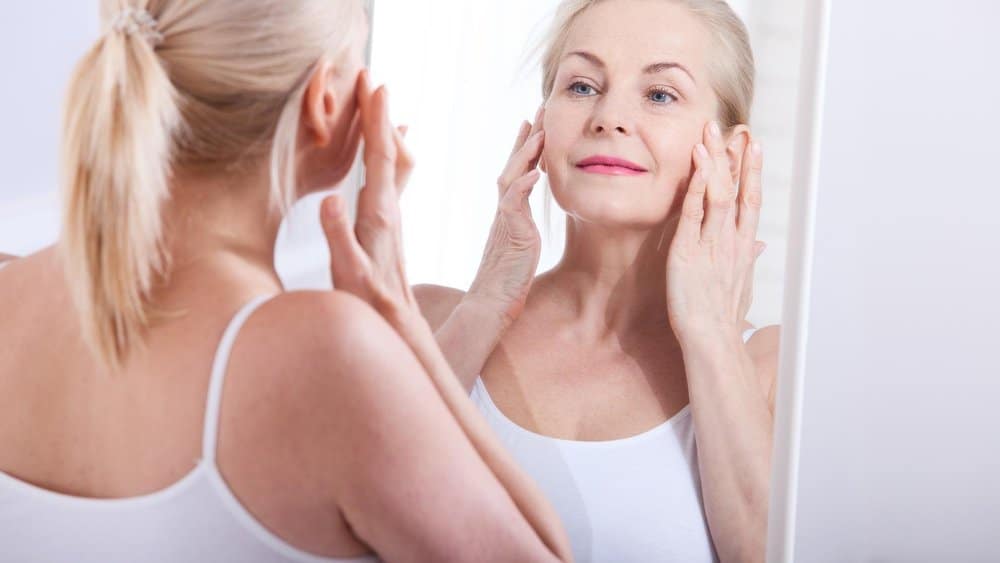Mother Nature gives with one hand and takes with another. After the rollercoaster ride of emotions in our twenties, surely we’ve earned wisdom and self-acceptance in our forties? But wait for the trade-off: a gradual drop in hormones known as perimenopause, affecting mind, body and skin. By fifty, dwindling hormone levels have dropped off a cliff. Goodbye, firm jawline. Hello, menopause: brain fog, aching joints and dry, brittle hair.
Why do we lose collagen during the menopause?
Menopause marks the end of the menstrual cycle: our ovaries stop releasing eggs and making the reproductive hormones oestrogen, progesterone and testosterone.
Brace yourself: loss of oestrogen during menopause is to blame for more collagen loss than chronological ageing. It’s up there with sun damage, excess sugar and smoking. By the time our periods have fizzled out, we’ve lost up to 50% of our collagen, and our skin is losing elasticity at a rate of knots. Collagen is the main structural protein found everywhere in the body: skin, nails, bones, and hair, so we need to replace it – fast.
How to replace lost collagen during the menopause
Let’s not get despondent. The end of our reproductive years should be the ultimate freedom – a time for reinvention. Let’s take control and embrace the ‘meno-mindset!’ Your body is telling you to slow down and focus on yourself after years of caring for everyone else.
We can’t stop ageing, but combining exercise, an anti-inflammatory diet and collagen sachets can restore lost collagen and ease menopausal symptoms. Menopause is a great time to start taking collagen sachets to help support healthy joints, bones, skin and hair. Like a savings account, they will pay off in the future.
Upgrade your skincare routine
The visible signs of collagen loss are staring us in the face: dullness, loss of elasticity and deepening lines – otherwise known as the Menopause Face. Blame lower oestrogen levels for weaker, thinner collagen fibres and a drop in elastin (responsible for skin ‘bounce’) and hyaluronic acid (responsible for skin pluming dewiness).
- Dryness & sensitivity
A drop in oestrogen levels means fewer lipids (skin oils), an impaired skin barrier and moisture loss; fragile menopausal skin can’t heal as quickly and is more prone to rosacea and eczema flare-ups. Dry, crepey skin can’t reflect the light as well as plump, hydrated skin, so switch to a richer moisturiser containing essential fatty acids to lock in moisture (unless you are experiencing hormonal breakouts) and avoid skin-sensitising essential oils.
Avoid foaming cleansers and wipes which strip your natural oils and remove make-up with a damp mitt instead of splashing with water. Avoid soaps, even natural ones, due to their alkaline pH, which can damage our microbiome (the delicate balance of good and bad bacteria living on our skin), leading to tight, papery skin.
- Sag no more.
We rely on collagen to hold up our skin like scaffolding – no wonder it settles into folds during menopause. However, collagen in moisturisers can’t penetrate the skin barrier and anti-ageing skincare actives such as retinol, AHAs, and Vitamin C can dry out a sensitive menopausal barrier even more.
Let’s be kind to fragile menopausal skin and stimulate collagen from the inside out. Yuvãfy Marine Collagen sachets cleverly trick your body into producing more collagen for smooth, firm, youthful skin. We have enriched our sachets with Hyaluronic Acid (to help our skin retain moisture), Vitamins C (to protect from pollution) and B to calm menopausal redness.
Strengthen hair & nails
We’re prepared for sagging jawlines and crepey necks, but no one warns us that hair becomes wiry or that expensive manicures are wasted on brittle nails. Upgrade to a moisturising shampoo and conditioner, but remember that hair is dead, so don’t expect long-term results. Collagen sachets help nourish and strengthen hair and nails from the inside out, preventing breakage.
Kickstart your metabolism
Did you know sluggish menopausal metabolism is directly linked to collagen and muscle loss? Toning up with strength training (resistance exercises or weights) will speed up your metabolism before you can say ‘middle-aged spread.’ How unfair that muscle cells need more maintenance than fat cells. Regular exercise and an anti-inflammatory diet can help your body burn harmful belly fat (which wraps around our organs, secreting proteins and pro-inflammatory hormones) instead of the subcutaneous fat just under the surface of your skin. (We need to hang onto that, or we look gaunt).
Strengthen bones and support creaking joints
Bones are mainly collagen, so it is no wonder bone mineral density drops dramatically during menopause, leading to an increased risk of osteoporosis and fractures. Because collagen also supports your cartilage, the rubber-like connective tissue that protects your joints, a drop can lead to a loss of mobility, flexibility, joint pain and stiffness. Over-the-counter remedies never really remedy aching joints; instead, go straight to the source and up your collagen levels with exercise and sachets.
Ignore the old wives’ tales that exercise wears your joints faster – our bodies are not designed to stay still. Exercise can improve mobility, prevent falls, regulate body temperature and reduce the intensity of hot flushes.
Avoid hot flush triggers such as spicy foods, caffeine, and alcohol. Follow a Mediterranean diet rich in olive oil, fruit, legumes, vegetables, fish and wholegrains to support bone health and higher muscle mass.
Boost Heart Health
Collagen is an essential but overlooked part of cardiac tissue, making up the walls of the blood vessels and heart. Collagen sachet can improve the function and structure of both.
By Charlotte Wilkes
Shop Yuvãfy





